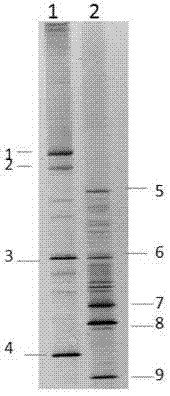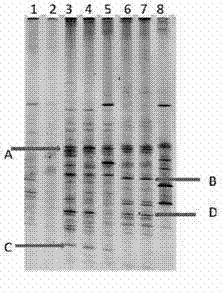Bacteria separation method for efficiently degrading high molecular weight polycyclic aromatic hydrocarbons and application thereof
A polycyclic aromatic hydrocarbon and bacteria technology, applied in the field of microbial technology and environmental biology, can solve problems such as few reports and achieve the effect of high degradation efficiency
- Summary
- Abstract
- Description
- Claims
- Application Information
AI Technical Summary
Problems solved by technology
Method used
Image
Examples
Embodiment 1
[0041] This embodiment provides a separation method for screening high-efficiency PAH-degrading bacterial complexes, which is specifically as follows:
[0042] 1. Add 50ml of sterilized distilled water and 10g of fresh high-concentration PAHs-contaminated soil into a 100ml Erlenmeyer flask, culture at 25-30°C, 90rpm.
[0043] 2. Add the acetone solution of pyrene and benzopyrene to two new sterilized Erlenmeyer flasks respectively, and make the acetone solution volatilize completely in the ultra-clean workbench, then add bacterial culture medium I, so that the final concentration of pyrene in polycyclic aromatic hydrocarbons is 200mg / L, the final concentration of benzopyrene is 10mg / L. Insert the bacteria cultured in the above 1 with 1% volume content, culture on a shaker in the dark at 25-30°C and 90rpm for 10 days, and repeat the operation from step 2 to step 1 for the degradation rate of pyrene and benzopyrene by the bacterial enrichment culture solution Until the stabili...
Embodiment 2
[0056] Embodiment 2: the degradation performance of efficient degrading bacteria to pyrene and benzopyrene in bacterial culture medium I
[0057] 1. Get the sterilized Erlenmeyer flask and add the acetone solution containing pyrene, and make the acetone solution volatilize completely in the ultra-clean workbench, then add bacterial culture medium I, so that the final concentration of pyrene in polycyclic aromatic hydrocarbons is 200mg / L. Insert the three strains obtained in the above step 9 respectively, under the condition of room temperature 90rpm, culture in a dark shaker for 2, 4, 6, 8, and 10 days, set 3 repeated experiments and bacterial culture medium I+200mg without inoculation / L pyrene was used as a control, and the effect of degrading pyrene of a single bacterial strain was determined by GC-MS ( figure 2 ).
[0058] Result: by figure 2It can be seen that mycobacteria have a strong ability to decompose pyrene, and the degradation rate of the pyrene solution with ...
Embodiment 3
[0066] Example 3: Degradation effect in long-term polluted soil with high concentration and high content of polycyclic aromatic hydrocarbons and the tracking detection of the added bacteria
[0067] 1. Experimental design:
[0068] The experiment was divided into 4 groups, each with 500g soil samples. They are sample 1: add distilled water; sample 2: raw soil without any treatment; sample 3: trace element solution + three kinds of bacteria; sample 4: bacterial culture medium I + 1% glucose + three kinds of bacteria.
[0069] 2. Bacterial culture
[0070] The strains purified from the three bacteria in the ninth step of Example 1 are respectively Acinetobacter sp., Microbacterium sp. and Mycobacterium sp., inoculated with the following medium, and cultured on a shaker for 24-48 hours at room temperature at 90 rpm to obtain 5×10 8 ~5×10 10 CFU / ml concentration of bacteria liquid. Culture medium composition: Add 10g-20g glucose and 3-15g sodium acetate per 20L of the above-m...
PUM
 Login to View More
Login to View More Abstract
Description
Claims
Application Information
 Login to View More
Login to View More - R&D
- Intellectual Property
- Life Sciences
- Materials
- Tech Scout
- Unparalleled Data Quality
- Higher Quality Content
- 60% Fewer Hallucinations
Browse by: Latest US Patents, China's latest patents, Technical Efficacy Thesaurus, Application Domain, Technology Topic, Popular Technical Reports.
© 2025 PatSnap. All rights reserved.Legal|Privacy policy|Modern Slavery Act Transparency Statement|Sitemap|About US| Contact US: help@patsnap.com



